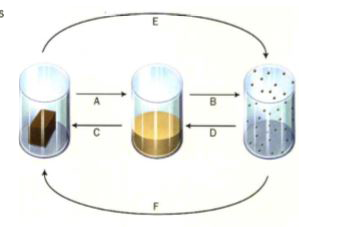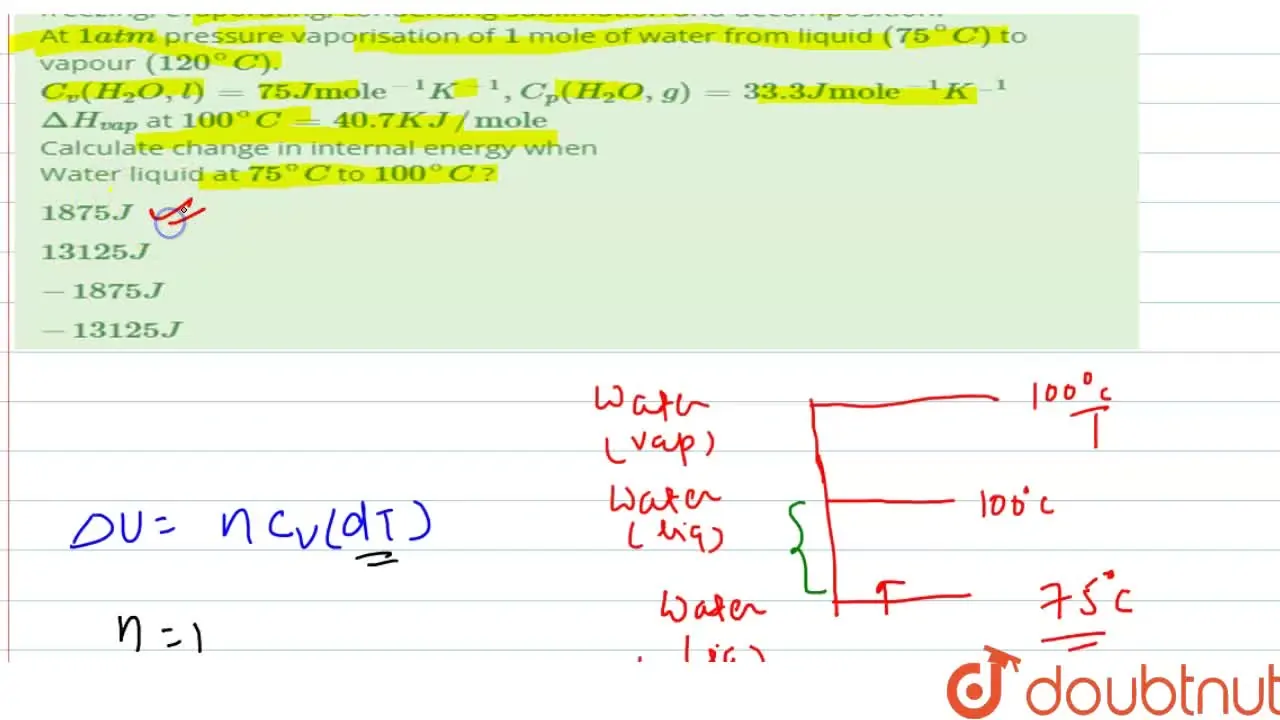Phase transitions are ubiquitous in nature. We are all familiar with the different phase of water (vapour, liquid and ice) and with the change from one to another, the change of phase are called phase transitions. There are six ways a substance can change between these three phase, melting, freezing, evaporating, condensing sublimation and decomposition.
At 1atm pressure vaporisation of 1 mole of water from liquid (75∘C) to vapour (120∘C).
Cv(H2O,l)=75Jmole−1K−1,Cp(H2O,g)=33.3Jmole−1K_1
ΔHvap at 100∘C=40.7KJ/mole
Calculate change in internal energy when
Water liquid at 75∘C to 100∘C ?
1875J
13125J
−1875J
−13125J
The correct Answer is:A
Step by step video & image solution for Phase transitions are ubiquitous in nature. We are all familiar with the different phase of water (vapour, liquid and ice) and with the change from one to another, the change of phase are called phase transitions. There are six ways a substance can change between these three phase, melting, freezing, evaporating, condensing sublimation and decomposition. At 1 atm pressure vaporisation of 1 mole of water from liquid (75^(@)C) to vapour (120^(@)C). C_(v)(H_(2)O,l)=75 J "mole"^(-1)K^(-1), C_(p)(H_(2)O,g)=33.3J"mole"^(-1)K^(_1) Delta H_(vap) at 100^(@)C=40.7KJ//"mole" Calculate change in internal energy when Water liquid at 75^(@)C to 100^(@)C ? by Chemistry experts to help you in doubts & scoring excellent marks in Class 12 exams.
Related Playlists
- BOOK - RESONANCE ENGLISHCHAPTER - THERMODYNAMICSEXERCISE - Exercise-3 Part-1: JEE (ADVANCED)11videos
THERMODYNAMICS
- BOOK - RESONANCE ENGLISHCHAPTER - THERMODYNAMICSEXERCISE - Main5videos
THERMODYNAMICS
- BOOK - RESONANCE ENGLISHCHAPTER - THERMODYNAMICSEXERCISE - Exercise 2- III : One or more than one options correct type14videos
THERMODYNAMICS
- BOOK - RESONANCE ENGLISHCHAPTER - TEST SERIESEXERCISE - CHEMISTRY50videos
TEST SERIES
Similar Questions
Phase transitions are ubiquitous in nature. We are all familiar with the different phase of water (vapour, liquid and ice) and with the change from one to another, the change of phase are called phase transitions. There are six ways a substance can change between these three phase, melting, freezing, evaporating, condensing sublimation and decomposition.
At 1atm pressure vaporisation of 1 mole of water from liquid (75∘C) to vapour (120∘C).
Cv(H2O,l)=75Jmole−1K−1,Cp(H2O,g)=33.3Jmole−1K_1
ΔHvap at 100∘C=40.7KJ/mole
Calculate change in internal energy when
Water liquid at 100∘C to vapour at 100∘C ?View SolutionPhase transitions are ubiquitous in nature. We are all familiar with the different phase of water (vapour, liquid and ice) and with the change from one to another, the change of phase are called phase transitions. There are six ways a substance can change between these three phase, melting, freezing, evaporating, condensing sublimation and decomposition.
At 1atm pressure vaporisation of 1 mole of water from liquid (75∘C) to vapour (120∘C).
Cv(H2O,l)=75Jmole−1K−1,Cp(H2O,g)=33.3Jmole−1K_1
ΔHvap at 100∘C=40.7KJ/mole
Calculate change in internal energy when
Water vapour at 100∘C to 120∘C ?View SolutionDefine first order phase transition?
View SolutionThe entropy change for a phase transformation is :
View SolutionHeat supplied to a solid changes it into liquid. What is this change in phase called ?
View SolutionDefine phase and phase difference.
View SolutionWhich phase of prophase-I represents the transition to metaphase I ?
View SolutionWhich of the following does not represent enthalpy change during phase transformation?
View SolutionWhich is the largest phase of M phase?
View SolutionWrite phase changes in the diagram.
 View Solution
View Solution


